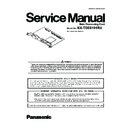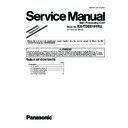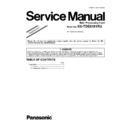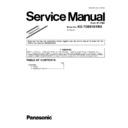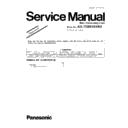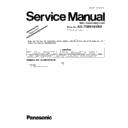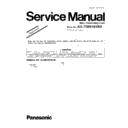Panasonic KX-TDE6101RU Service Manual ▷ View online
ORDER NO. KMS0901644CE
Main Processing Card
Model No.
KX-TDE6101RU
(for Russia and Ukraine)
2
KX-TDE6101RU
TABLE OF CONTENTS
PAGE
PAGE
1 Safety Precautions -----------------------------------------------3
1.1. For Service Technicians ---------------------------------3
2 Warning --------------------------------------------------------------3
2.1. Battery Caution ---------------------------------------------3
2.2. Discarding of P. C. Board --------------------------------3
2.3. About Lead Free Solder (PbF: Pb free) --------------4
2.2. Discarding of P. C. Board --------------------------------3
2.3. About Lead Free Solder (PbF: Pb free) --------------4
2.3.1. Suggested PbF Solder -------------------------------4
3 Specifications ------------------------------------------------------5
3.1. General Description ---------------------------------------5
4 Technical Descriptions------------------------------------------6
4.1. IPCEMPR Block Diagram --------------------------------6
4.2. IPCEMPR Card Circuit Operation ------------------- 10
4.2. IPCEMPR Card Circuit Operation ------------------- 10
4.2.1. IPCEMPR Card -------------------------------------- 10
4.2.2. Description of Each Part--------------------------- 11
4.2.3. Circuit Description----------------------------------- 12
4.2.2. Description of Each Part--------------------------- 11
4.2.3. Circuit Description----------------------------------- 12
4.3. Outline ------------------------------------------------------ 15
4.3.1. IPCEMPR Card -------------------------------------- 15
4.3.2. Back Board-------------------------------------------- 15
4.3.3. Power Supply Unit ---------------------------------- 15
4.3.4. System Control--------------------------------------- 15
4.3.2. Back Board-------------------------------------------- 15
4.3.3. Power Supply Unit ---------------------------------- 15
4.3.4. System Control--------------------------------------- 15
5 Location of Controls and Components------------------ 18
5.1. Name and Locations ------------------------------------ 18
6 Installation Instructions--------------------------------------- 19
6.1. Information about the Main Processing Card ----- 19
6.1.1. IPCEMPR Card -------------------------------------- 19
7 Troubleshooting Guide---------------------------------------- 21
7.1. IPCEMPR Card------------------------------------------- 21
7.1.1. Startup-------------------------------------------------- 21
7.1.2. Phone Call -------------------------------------------- 30
7.1.3. Paging-------------------------------------------------- 31
7.1.4. Using MOH-------------------------------------------- 35
7.1.5. LAN ----------------------------------------------------- 38
7.1.6. SVM----------------------------------------------------- 39
7.1.7. RS-232C----------------------------------------------- 40
7.1.8. SD card IF--------------------------------------------- 41
7.1.9. Other---------------------------------------------------- 42
7.1.2. Phone Call -------------------------------------------- 30
7.1.3. Paging-------------------------------------------------- 31
7.1.4. Using MOH-------------------------------------------- 35
7.1.5. LAN ----------------------------------------------------- 38
7.1.6. SVM----------------------------------------------------- 39
7.1.7. RS-232C----------------------------------------------- 40
7.1.8. SD card IF--------------------------------------------- 41
7.1.9. Other---------------------------------------------------- 42
7.1.10. BUS-M Card ------------------------------------------ 43
7.2. MEC Card -------------------------------------------------- 44
8 Miscellaneous ---------------------------------------------------- 45
8.1. How To Replace a Flat Package IC ----------------- 45
8.1.1. Preparation-------------------------------------------- 45
8.1.2. Removal Procedure--------------------------------- 45
8.1.3. Procedure --------------------------------------------- 45
8.1.4. Removing Solder From Between Pins --------- 45
8.1.2. Removal Procedure--------------------------------- 45
8.1.3. Procedure --------------------------------------------- 45
8.1.4. Removing Solder From Between Pins --------- 45
8.2. Terminal Guide of the ICs Transistors and
Diodes------------------------------------------------------- 46
8.3. Memo-------------------------------------------------------- 47
9 Schematic Diagram--------------------------------------------- 48
9.1. Block Diagram -------------------------------------------- 48
9.2. IPCEMPR Card No.1------------------------------------ 50
9.3. IPCEMPR Card No.2------------------------------------ 52
9.4. IPCEMPR Card No.3------------------------------------ 54
9.5. IPCEMPR Card No.4------------------------------------ 56
9.6. IPCEMPR Card No.5------------------------------------ 58
9.7. IPCEMPR Card No.6------------------------------------ 60
9.8. IPCEMPR Card No.7------------------------------------ 62
9.9. IPCEMPR Card No.8------------------------------------ 64
9.2. IPCEMPR Card No.1------------------------------------ 50
9.3. IPCEMPR Card No.2------------------------------------ 52
9.4. IPCEMPR Card No.3------------------------------------ 54
9.5. IPCEMPR Card No.4------------------------------------ 56
9.6. IPCEMPR Card No.5------------------------------------ 58
9.7. IPCEMPR Card No.6------------------------------------ 60
9.8. IPCEMPR Card No.7------------------------------------ 62
9.9. IPCEMPR Card No.8------------------------------------ 64
9.10. IPCEMPR Card No.9------------------------------------ 66
9.11. IPCEMPR Card No.10 --------------------------------- 68
9.12. IPCEMPR Card No.11---------------------------------- 70
9.13. IPCEMPR Card No.12 --------------------------------- 72
9.14. IPCEMPR Card No.13 --------------------------------- 74
9.15. IPCEMPR Card No.14 --------------------------------- 76
9.16. IPCEMPR Card No.15 --------------------------------- 78
9.17. IPCEMPR Card No.16 --------------------------------- 80
9.18. MEC Card ------------------------------------------------- 81
9.19. Waveform-------------------------------------------------- 83
9.13. IPCEMPR Card No.12 --------------------------------- 72
9.14. IPCEMPR Card No.13 --------------------------------- 74
9.15. IPCEMPR Card No.14 --------------------------------- 76
9.16. IPCEMPR Card No.15 --------------------------------- 78
9.17. IPCEMPR Card No.16 --------------------------------- 80
9.18. MEC Card ------------------------------------------------- 81
9.19. Waveform-------------------------------------------------- 83
10 Printed Circuit Board------------------------------------------ 85
10.1. IPCEMPR Card ------------------------------------------ 85
10.1.1. Component View------------------------------------ 85
10.1.2. Flow Solder Side View----------------------------- 86
10.1.2. Flow Solder Side View----------------------------- 86
10.2. MEC Card ------------------------------------------------- 87
10.2.1. Component View------------------------------------ 87
10.2.2. Flow Solder Side View----------------------------- 87
10.2.2. Flow Solder Side View----------------------------- 87
11 Appendix Information of Schematic Diagram -------- 88
12 Exploded View and Replacement Parts List----------- 89
12.1. IC Data ----------------------------------------------------- 89
12.1.1. IC101--------------------------------------------------- 89
12.2. Cabinet and Electric Parts----------------------------- 97
12.3. Accessories and Packing Materials----------------- 98
12.4. Replacement Parts List -------------------------------- 99
12.3. Accessories and Packing Materials----------------- 98
12.4. Replacement Parts List -------------------------------- 99
12.4.1. Cabinet and Electrical Parts---------------------- 99
12.4.2. Accessories and Packing Materials ------------ 99
12.4.3. Main Board Parts ----------------------------------- 99
12.4.4. MEC Board Parts ----------------------------------108
12.4.2. Accessories and Packing Materials ------------ 99
12.4.3. Main Board Parts ----------------------------------- 99
12.4.4. MEC Board Parts ----------------------------------108
3
KX-TDE6101RU
1 Safety Precautions
1.1.
For Service Technicians
• Repair service shall be provided in accordance with repair technology information such as service manual so as to prevent fires,
injury or electric shock, which can be caused by improper repair work.
1. When repair services are provided, neither the products nor their parts or members shall be remodeled.
2. If a lead wire assembly is supplied as a repair part, the lead wire assembly shall be replaced.
3. FASTON terminals shall be plugged straight in and unplugged straight out.
2. If a lead wire assembly is supplied as a repair part, the lead wire assembly shall be replaced.
3. FASTON terminals shall be plugged straight in and unplugged straight out.
• ICs and LSIs are vulnerable to static electricity.
When repairing, the following precautions will help prevent recurring malfunctions.
1. Cover plastic parts boxes with aluminum foil.
2. Ground the soldering irons.
3. Use a conductive mat on worktable.
4. Do not grasp IC or LSI pins with bare fingers.
2. Ground the soldering irons.
3. Use a conductive mat on worktable.
4. Do not grasp IC or LSI pins with bare fingers.
2 Warning
2.1.
Battery Caution
1. Danger of explosion if battery is incorrectly replaced. Replace only with the same or equivalent type recommended by the
manufacturer. Dispose of used batteries according to the manufacturer's lnstructions.
2. The lithium battery is a critical component (type No.CR23541). Please observe for the proper polarity and the exact location
when replacing it and soldering the replacement lithium battery in.
2.2.
Discarding of P. C. Board
When discarding P. C. Board, delete all personal information such as telephone directory and caller list or scrap P. C. Board.
4
KX-TDE6101RU
2.3.
About Lead Free Solder (PbF: Pb free)
Note:
In the information below, Pb, the symbol for lead in the periodic table of elements, will refer to standard solder or solder that con-
tains lead.
We will use PbF when discussing the lead free solder used in our manufacturing process which is made from Tin, (Sn), Silver,
(Ag), and Copper, (Cu).
This model, and others like it, manufactured using lead free solder will have PbF stamped on the PCB. For service and repair
work we suggest using the same type of solder.
tains lead.
We will use PbF when discussing the lead free solder used in our manufacturing process which is made from Tin, (Sn), Silver,
(Ag), and Copper, (Cu).
This model, and others like it, manufactured using lead free solder will have PbF stamped on the PCB. For service and repair
work we suggest using the same type of solder.
Caution
• PbF solder has a melting point that is 50
° ~ 70° F, (30° ~ 40°C) higher than Pb solder. Please use a soldering iron with tempera-
ture control and adjust it to 700
° ± 20° F, (370° ± 10°C).
Exercise care while using higher temperature soldering irons.:
Do not heat the PCB for too long time in order to prevent solder splash or damage to the PCB.
Do not heat the PCB for too long time in order to prevent solder splash or damage to the PCB.
• PbF solder will tend to splash if it is heated much higher than its melting point, approximately 1100
°F, (600°C).
• When applying PbF solder to double layered boards, please check the component side for excess which may flow onto the
opposite side (See figure, below).
2.3.1.
Suggested PbF Solder
There are several types of PbF solder available commercially. While this product is manufactured using Tin, Silver, and Copper,
(Sn+Ag+Cu), you can also use Tin and Copper, (Sn+Cu), or Tin, Zinc, and Bismuth, (Sn+Zn+Bi). Please check the manufac
turer's specific instructions for the melting points of their products and any precautions for using their product with other
materials.
The following lead free (PbF) solder wire sizes are recommended for service of this product: 0.3mm, 0.6mm and 1.0mm.
(Sn+Ag+Cu), you can also use Tin and Copper, (Sn+Cu), or Tin, Zinc, and Bismuth, (Sn+Zn+Bi). Please check the manufac
turer's specific instructions for the melting points of their products and any precautions for using their product with other
materials.
The following lead free (PbF) solder wire sizes are recommended for service of this product: 0.3mm, 0.6mm and 1.0mm.

